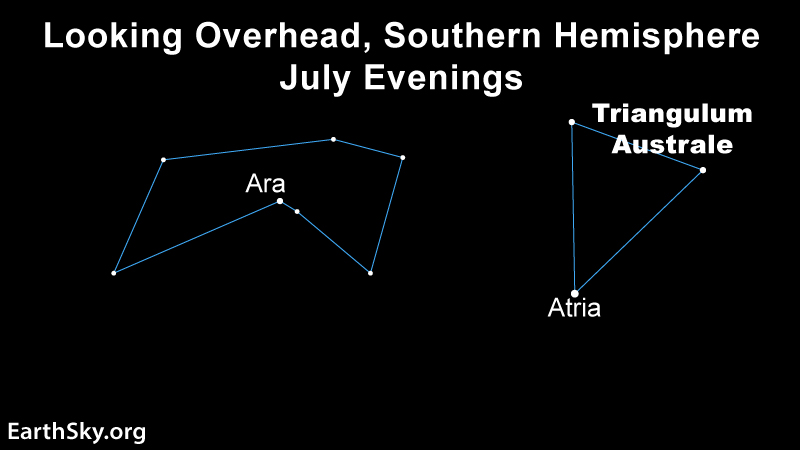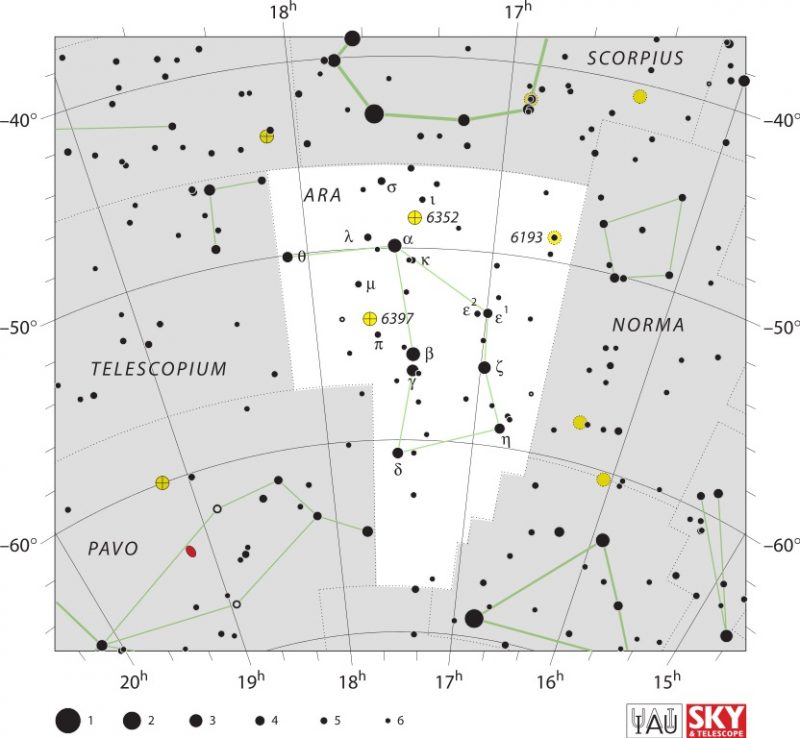
Ara and Triangulum Australe
Ara the Altar is a small constellation that touches Corona Australis at one corner and lies south of Scorpius the Scorpion. Next to it is Triangulum Australe the Southern Triangle. Also, you can find Triangulum Australe easily by star-hopping over from nearby Alpha Centauri, the 3rd-brightest star in the sky. And both of these diminutive constellations will be overhead on July evenings in the Southern Hemisphere.
Ara the Altar
Ara’s main stars form a rectangular shape that is slightly collapsed along one of its long sides. Along this sunken side you’ll find one of two stars tied for brightest in the constellation, Beta Arae at magnitude 2.84. It lies 603 light-years away.
Then, less than a degree to the south is Gamma Arae at magnitude 3.5 and 1,140 light-years distant. Continuing on to one corner of the collapsed rectangle is Delta Arae at magnitude 3.60 and 187 light-years distant. The star at the next corner is 3.77 magnitude Eta Arae at a distance of 313 light-years. Just over 3 degrees away is magnitude 3.12 Zeta Arae at a distance of 574 light-years. In the next corner is the other star tied for brightest, Alpha Arae at magnitude 2.84 and 240 light-years away. And in the last corner is Theta Arae at magnitude 3.65 and a distance of 1,013 light-years.
Also, there are some minor deep-sky targets in Ara. One of the brightest is also one of the easiest to find. About 1/3 of the way from Beta to Theta is globular cluster NGC 6397. It shines at magnitude 5.7 and is one of the nearest globular clusters, at a distance of 7,200 light-years.

Triangulum Australe the Southern Triangle
Triangulum Australe the Southern Triangle is not far from the south celestial pole. That means for many locations in the Southern Hemisphere, Triangulum Australe is circumpolar. This means it never sets below the horizon.
Triangulum Australe’s three brightest stars are the three that mark each corner of the triangle. The brightest is Alpha Trianguli Australis, also known as Atria. Atria is magnitude 1.91 and lies 391 light-years away. The last two triangle stars are nearly the same magnitude. Beta Trianguli Australis is the one on the side near Ara. Beta Trianguli Australis is magnitude 2.85 at a distance of 40 light-years. The last star in the triangle is Gamma Trianguli Australis at magnitude 2.87 and a distance of 184 light-years.
On the northern borders of Triangulum Australe lies the open star cluster named NGC 6025. At magnitude 5.09, the cluster lies about 2,700 light-years away and is a fair sight through binoculars.

Bottom line: Ara and Triangulum Australe are two constellations in southern skies representing an Altar and the Southern Triangle. See them on July evenings.











